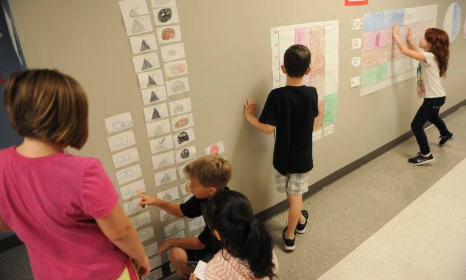What is project-based learning in kindergarten?
A year of PBL through kinder Math ideas
By Jenny Pieratt
A year of PBL through kinder Math ideas
By Jenny Pieratt
Most educators consider the humanities to be PBL friendly, and while combining math and project-based learning can be daunting, throwing kindergarten students into the mix seems to make for a terrifying trio. Once you start planning the year, however, you’ll find it couldn’t be easier. So, what is project-based learning in kindergarten? Amongst other things, it’s organizing your curriculum around critical math concepts and getting through a few Common Core State Standards in mathematics, as students learn to represent and operate on whole numbers as well as understand space and shapes. But it can also be about letting students guide their own learning through amazing educational projects with concrete applications in real life. Let’s get down to it and see how you can develop captivating mathematics-centered projects for your kindergarten class from September all the way through to June!
Making Summer Last
Fall is one of the best times to grow a garden and teach your class the math basics, like how to use numbers, model quantities, identify shapes, and count objects, critical Common Core standards. Numerous studies show that garden-based learning, the combination of gardening and PBL, can improve students’ academic achievement, encourage healthy lifestyles as well as community development, and help youth develop stewardship. For example, Milkweed for Monarchs is a garden project at Calavera Hills Middle School. Students there noticed that butterfly populations have been plummeting throughout North America and that monarch larva feeds itself almost exclusively with milkweed. That’s why planting milkweed and measuring their growth, leaf size, and shape day by day can help one of your class’ favorite insects thrive while learning math. When teachers ask: “What is project-based learning in kindergarten?” it’s because they’re (understandably) worried about confusing 5-year-olds with a bunch of new concepts and high expectations. The key is to start with what they know. What about the weather?
In this down-to-earth article, Cathy Janes explains how to have your students construct rain gauges together from recycled materials and model rainfall over a few weeks or observe and draw different cloud formations. You can then guide your class as they research rain patterns in drought-struck areas around the United States and become aware of the importance of conserving freshwater.
Playing Through Winter
Swing sets, jungle gyms, tires, seesaws, monkey bars, merry-go-rounds, slides, and tunnels – the list of fun playground games is endless! By observing playground equipment, students can learn to describe the world around them with geometric ideas, identify 2D and 3D shapes, and develop their spatial reasoning – all part of the Common Core standards. In this CraftEd piece, Dave Lesinski at Flora Vista Elementary answered the question “What is project-based learning in kindergarten?” with another question: “How can we use math (counting and tracking data) to come up with ideas for a new playground at Flora Vista?” Launch your own class project by asking students to interview a few adults and peers about their favorite playgrounds, then guide them as they use the collected data to design a new playground full of geometric shapes. The final product, a model of their potential new school playground, should not only show their mathematics learning but also their observance of constraints such as safety, cost, and of course, fun! The results can be shared with other grades as well as with the principal – all key stakeholders in the playground business, of course.
Starting Out Strong in Spring
Ingvar Kamprad, the founder of Ikea, was just 5-years-old when he started selling matches from door to door in his Swedish hometown. That’s something to keep in mind when wondering what project-based learning in kindergarten can look like. Indeed, teaching your students about counting and cardinality shouldn’t involve writing on a blackboard for an hour… or yawning. Assist your students as they kick off the new year with innovative business projects – have them visit startups and talk with business pioneers and then brainstorm for ideas. Each of them can then create a business plan that will answer to an unfulfilled need or desire in their community, whether that is for a particular service, snack, or slingshot.
GRANT JEFFERIES/Bradenton Herald
If that sounds way too complicated, just know that 8-year-old entrepreneurs have done this successfully at Mills Elementary School before. The result of their hard work was an exhibition of their storefronts in the school cafeteria with a competitive aspect – who could sell out first? So, the next time somebody asks you: “What is project-based learning in kindergarten?” – you can say that’s it’s challenging students with engaging business ventures. Entrepreneurship is also full of mathematics and Common Core standards, such as determining the cost of materials and manual labor, setting prices, graphing their progress, budgeting, learning the business vocabulary such as “product” and “revenue”. You can learn more about how to teach entrepreneurship through PBL right here.
What is project-based learning in kindergarten? The truth is that it could be anything. But if you don’t know where to start, having your kindergarteners complete Common Core mathematics standards through PBL is a challenging, fun, and fulfilling experience. Whether it’s by diving into garden-based learning to help their community in fall, designing their own playground utopia through winter, or developing an entrepreneurial spirit in springtime, your class will learn all about basic mathematical basics in just one year of memorable experiences.

